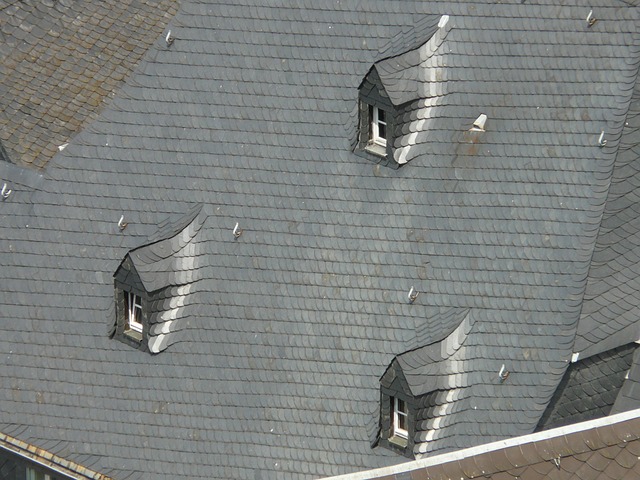Understanding roofing material cost factors is crucial for effective roofing project budgeting. Durability, installation complexity, brand, color, style, environmental factors, and local market dynamics influence prices. Long-lasting options like metal or tile, though more expensive upfront, offer better value due to reduced replacement needs. Easier-to-install materials like shingles are cheaper. Budgeting should consider national trends and regional variations. Metal roofing is a durable investment for long-term savings, while tile enhances curb appeal with customization options. Shingle roofing is cost-effective and easy to install but requires considering labor costs and material varieties. Smart budgeting through research, multiple quotes, and factoring in material/labor costs plus potential rebates ensures accurate projections for your roofing project.
“Roofing materials play a pivotal role in any construction or renovation project, impacting both structure integrity and aesthetic appeal. This article guides you through the cost comparison of popular choices—metal, tile, and shingles—essential for effective roofing project budgeting. We explore key factors influencing material prices, offering insights into each option’s financial commitment. From metal’s durability to tile’s luxury and shingles’ affordability, understand cost dynamics to make informed decisions for your roofing project.”
Understanding the Cost Factors for Roofing Materials
When planning a roofing project, understanding the cost factors behind different materials is essential for effective budgeting. The price of roofing materials can vary greatly depending on several variables. One significant factor is durability; longer-lasting materials like metal or tile tend to be more expensive upfront but offer better value over time as they require less frequent replacement.
Another crucial aspect is installation complexity, with some materials, such as shingles, being easier and cheaper to install due to their widespread use and readily available labor. Moreover, the cost can differ based on brand, color, and style choices, with premium options driving up prices. Environmental factors and local market dynamics also play a role in pricing, ensuring that roofing project budgeting considers both national trends and regional variations.
Metal Roofing: Durability Meets Budget Considerations
Metal roofing stands out for its exceptional durability, offering long-lasting protection against the elements. This makes it a wise investment in the long term, as it can withstand high winds, heavy rain, and even fires, ensuring your home remains secure. However, when considering a metal roofing project, budgeting is key. While initial costs might be higher compared to traditional shingles or tile, metal roofs have a lower lifecycle cost. They require minimal maintenance, repair, and replacement over their extensive lifespan, making them a financially prudent choice for homeowners looking to enhance their roofing project’s budgeting.
Tile Roofing: An Investment in Quality and Style
Tile roofing is often seen as an investment in both quality and style, making it a popular choice for homeowners looking to enhance their property’s curb appeal. While the upfront costs can be higher compared to other materials, tile roofs are known for their durability and long-lasting performance. In terms of roofing project budgeting, tiles offer a range of options, from traditional clay to modern, low-maintenance varieties, each with its own price point. However, their superior craftsmanship and resistance to extreme weather conditions ensure they stand the test of time, potentially reducing long-term replacement costs.
When considering a roofing project, tile’s aesthetic appeal cannot be overlooked. It adds a sense of elegance and sophistication to any home, boosting its overall value. Moreover, tiles are available in various colors and styles, allowing homeowners to customize their roof to complement their architectural design. This level of versatility makes tile roofing an excellent choice for those looking to create a unique and visually stunning exterior.
Shingle Roofing: Affordability and Common Expenses
Shingle roofing is a popular choice for many homeowners due to its affordability and ease of installation. When it comes to budgeting for a roofing project, shingles offer a cost-effective solution compared to other materials like metal or tile. The primary expense with shingle roofing revolves around labor costs, as skilled roofers are needed to install the shingles properly, ensuring they are securely fastened and weatherproof.
Common expenses for a shingle roofing project include materials such as shingles themselves, underlayment, flashing, and fasteners. While the cost of shingles can vary depending on the type (asphalt, wood, or fiber cement), the overall price is generally lower than other options, making it an attractive choice for homeowners looking to stay within budget for their roofing project.
Tips for Smart Budgeting in a Roofing Project
When planning a roofing project, smart budgeting is crucial. First, conduct thorough research on different materials to understand their cost ranges. Metal roofing, for instance, might have a higher upfront cost but offers longevity and reduced maintenance expenses over time. Shingles, the most common choice, provide good value for money, while tile can be more expensive but adds aesthetic appeal and durability.
Next, get multiple quotes from reputable contractors to gauge market rates accurately. Factor in not just material costs but also labor, which significantly impacts the overall budget. Consider energy-efficient or recycled materials for potential rebates or tax incentives that can offset initial expenses. Lastly, set a realistic reserve for unexpected repairs or unforeseen circumstances, ensuring your roofing project budgeting is flexible and well-prepared.
When considering a roofing project, understanding the cost factors of different materials is key. Each option—from metal to tile and shingles—offers unique advantages and budget considerations. Metal roofing excels in durability but varies in price, while tile roofing is an investment in quality and style, though more expensive upfront. Shingles remain a popular choice for their affordability. By navigating these options and implementing smart budgeting tips, you can ensure your roofing project aligns with your financial goals without compromising on protection and aesthetics.
